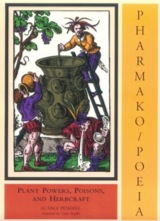Book Review






In Dale Pendell’s, Pharmako/Poeia: Plant Powers, poisons, and Herbcraft, Pendell discusses a variety of plants, drugs, and the history behind their uses. The book begins with a discussion about ‘Plant People’ and the history of powerful plants. He then goes on to describe the history, chemical properties, and many different facts about Thanatopathia, inebriantia, rhapsodica, euphorica, pacifica, existential, evanesthetica and metaphysica. Concluding with a glossary and references, this is the first book in a three-part series that Pendell has written.
The format of his book is not like a normal book, there are many quotes, many poems, and it does not read like a classic story, instead it jumps around a lot from history to chemical information and back. At the beginning of each section on a new chemical he gives both the plant name and the chemical name, along with the chemistry of the plant, how the drug is taken (and what doses are lethal), details about the plant itself, and what effects the plant has on the body. He then goes on to describe other plants in its family and discusses how the drug is used. He also has the description of the plants for medicinal uses and standards established by the FDA for the use as medicines.
The section on Thanatopathia begins with a discussion on healing and that healing requires being sick. Tobacco is the first chemical discussed in the Thanatopathia section, he describes how the art of smoking tobacco came about, and how kicking the addiction to the drug is very difficult. Nicotine is a primary alkaloid, and the percentage of alkaloids in tobacco products varies between strain and manufacturer. He discusses how the cigarette helps people kill time while they are waiting to die, and that the tobacco plant causes an addiction that is nearly impossible to kick 100%.
The next section is on the drugs that cause Inebriantia, where he talks mostly about the plants that alcohol is derived from. The specific plants that are mentioned are yeast, grapevine wine, barley malt, and Alcohol (the Water of Life). As in the previous section he discusses in detail the history and chemistry of the before mentioned plants. The ending of the chapter goes into how alcohol can lead to subtle addictions, which are most often denied.
Ether is the third section of plants that is discussed; and many different poisons come from the ether plants. There is a long history of chemicals derived from ethers being used as poisons, including chloroform, nitrous oxide, ethylene and other such compounds. These drugs must be inhaled or taken orally to target the organs. Fossil Fuel is another poison that is discussed at length in the ether section, and it exists in many different compounds including hexane, gasoline, toluene, spray paint, hair spray etc.
The rest of the sections discussed follow the general pattern of discussing the plants that are contained in a subsection of drugs, and their general history, chemical properties, and the effects that they have on the body. The other sections are listed below, and the sub categories of plants are listed as well.
•Rhapsodica Absinth (wormwood) and Dog Grass
•Euphorica Opium Poppy, Heroin
•Pacifica Kava Kava
•Existentia Salvia Divinorum
•Evaesthetica Cannabis Sativa
•Metaphysica Nitrous Oxide
This book follows a very interesting pattern of presenting material and presenting it in a manner that is interesting to read and understand. The author has a sense of humor about the plants and how they are used in drugs and hallucinogens. He discusses not only the chemical properties of the plants, but the history of their uses and how they affect the body.
The topics that he discusses cover most of the plants that we are going to be studying this semester in Natural Products. It is a good overview of the basics of many of the plants that are used to make drugs, both about their history and their chemistry. There are a ton of illustrations that help with the telling of his story and the description of the plants.
"The poison path is the narrow way, the twisting path, or no path at all. You could make it, O Nobly Born, you just might survive, yes, but who could follow you? Better to send them down the big road, well trodden and paved, this Poison Path is no shortcut. The Poison Path is best suited to tricksters and magicians who, if the stories are to be believed, come back to life after getting killed.”
Pendell, pg 226-237
Monday, January 30, 2012


Phamako Poeia - Dale Pendell






